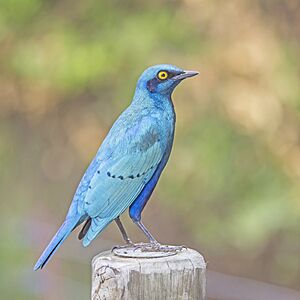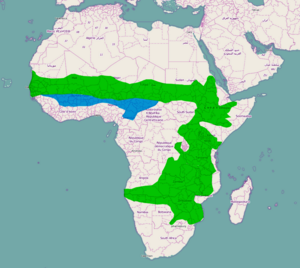Greater blue-eared starling facts for kids
Quick facts for kids Greater blue-eared starling |
|
|---|---|
 |
|
| L. c. nordmanni Kruger National Park, South Africa |
|
| Conservation status | |
| Scientific classification | |
| Genus: |
Lamprotornis
|
| Species: |
chalybaeus
|
 |
|
|
resident range
dry season visitor
|
|
The greater blue-eared starling is a beautiful bird known for its shiny, colorful feathers. You might also hear it called the greater blue-eared glossy-starling. Its scientific name is Lamprotornis chalybaeus. These birds live in many parts of Africa. They can be found from Senegal in the west, all the way east to Ethiopia. They also live south through eastern Africa, reaching northeastern South Africa and Angola. This starling is very common in open woodlands. Sometimes, these birds travel to different places depending on the season. This is called seasonal migration.
Contents
Types of Greater Blue-Eared Starlings
Just like people from different countries might look a little different, birds of the same species can also have slight variations. These variations are called subspecies. There are four main types, or subspecies, of the greater blue-eared starling:
- Lamprotornis chalybaeus chalybaeus: These birds live in the Sahel region of Africa.
- Lamprotornis chalybaeus cyaniventris: You can find this type in northeastern Africa.
- Lamprotornis chalybaeus nordmanni: This subspecies lives in southern Africa.
- Lamprotornis chalybaeus scyobius: These starlings are found in central and East Africa.
What Does the Greater Blue-Eared Starling Look Like?
The greater blue-eared starling is about 22 centimeters (about 8.7 inches) long. It has a short tail. This starling is very striking with its glossy blue-green feathers. Its belly is a pretty purple-blue color. It also has a distinct blue patch near its ears. The eyes of this bird are bright yellow or orange. Both male and female starlings look very similar. However, young starlings are a bit duller in color. Their underparts are more of a blackish-brown.
Sometimes, the starlings living in southern Kenya and further south are smaller. Some experts think they might be a separate subspecies called L. c. sycobius.
There's another bird called the lesser blue-eared starling. It looks a lot like our greater blue-eared starling. But you can tell them apart by looking at their bellies. On the lesser blue-eared starling, the blue color on its belly does not reach as far forward as its legs.
These starlings make a variety of sounds. They have musical calls and some grating sounds. One of their most common calls sounds like a nasal squee-ar.
Life Cycle and Behavior
Reproduction and Nests
The greater blue-eared starling builds its nests in holes in trees. These holes can be natural openings. They can also be holes made by other birds like woodpeckers or barbets. Sometimes, they even nest inside the large stick nests of other birds. These include the sacred ibis or Abdim's stork. A female starling usually lays three to five eggs. The eggs are often greenish-blue with brown or purple spots. They hatch in about 13 to 14 days. The baby chicks stay in the nest for about 23 days after they hatch.
Sometimes, other birds try to lay their eggs in the starling's nest. This is called brood parasitism. The great spotted cuckoo often does this. Occasionally, the greater honeyguide might also try.
Roosting and Flocks
Greater blue-eared starlings are very social birds. They love to be in large groups, called flocks. Often, they will join up with other types of starlings too. When they sleep, they gather in large groups called roosts. These roosts can be in reedbeds, thorny bushes, or acacia trees. They often share these sleeping spots with other birds.
Feeding Habits
Like many other starlings, the greater blue-eared starling is an omnivore. This means it eats both plants and animals. They eat a wide variety of foods. Their diet includes many different invertebrates (like insects). They also eat seeds and berries, especially figs. However, their main food source is insects. They usually find these insects on the ground.
You might sometimes see these starlings perching on farm animals like cows. They do this to eat insects that the animals stir up. They also sometimes pick off tiny creatures, called ectoparasites, that live on the animals' skin.


